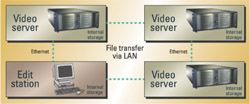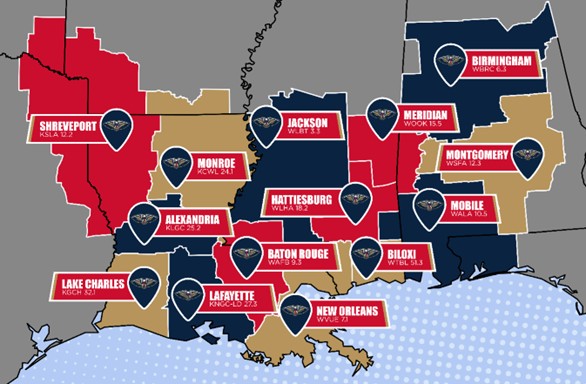Video server technology
Although rarely viewed as glamorous, video servers fulfill many important roles in modern broadcast facilities. They are most commonly found as key components of the production or playout system, where their reliability and interoperability with the rest of the system is vital. Despite the apparent simplicity of what video servers do, today’s broadcasters have difficult choices to make when selecting suitable products.

Figure 1. A Level 1 server system architecture consists of a simple server with internal storage. It has video and audio I/O and capability for external control via Ethernet or serial RS-422 protocols, but no file format interchange. Figures courtesy of Gee Broadcast Systems. Click here to see an enlarged diagram.
Broadcasters need something that can meet their requirements now and into the future. With present needs so variable, the nature of those future requirements is not often clear, but it will almost certainly include multiple delivery capability. At the same time, careful consideration should be given to the total cost of ownership of server solutions and their impact on operational and support systems. The introduction of a new server solution into an existing operation needs careful planning, both for the technical integration and operational changeover, as well as for any procedural changes and related training.
Server types
Early servers offered a standalone box solution that required significant external control systems to enable user-friendly operation. Such servers also had limited expansion possibilities, although some degree of network interconnection was later added to facilitate file transfer, as a first step towards an integrated approach.
Servers have developed to be highly integrated systems, with shared media and databases. User interfaces have become more closely integrated with the media and associated metadata, and this has brought about improved efficiency while reducing overall cost. Servers must now cope with multiple roles, including ingest, media logging and management, editing, and play-out. Performing these roles can be quite different for sports and news programming compared to, for example, movie playout.

Figure 2. A Level 2 server system architecture has several Level 1 servers interconnected via Ethernet. Material can be simply moved between servers or to editors attached to the same network. A limited amount of file sharing may also be possible, but storage is still integral to the different workstations/servers. Click here to see an enlarged diagram.
Several different server system architectures currently exist, ranging from the simple standalone box through networked systems, storage area networks (SANs) and hybrid systems. Users often will need a path to progress through these different stages as their operational requirements change and grow.
The professional video industry's #1 source for news, trends and product and tech information. Sign up below.
Level 1 is a simple server with internal storage. It has video and audio I/O and capability for external control via Ethernet or serial RS-422 protocols, but no file format interchange. (See Figure 1.)
Level 2 has a number of Level 1 servers interconnected via Ethernet. Here, material can be simply moved between servers or to editors attached to the same network. A limited amount of file sharing may also be possible, but storage is still integral to the different workstations/servers. (See Figure 2.)
Level 3 uses a fiber channel SAN architecture to provide central storage. All connected servers (and editors) can directly access material on the SAN and include functionality such as instant editing, where files still being captured are simultaneously edited. (See Figure 3.) Ideal for news and sports, Level 4 combines the networking and SAN technologies to provide an effective solution. For example, a football match being recorded on one server can be edited to produce highlights. These highlights can then be delivered to transmission via another server and simultaneously transferred over Ethernet for delivery to an IP service for the Internet and mobile phones — all while the game is in progress. (See Figure 4.) What makes this progression attractive is that users buying in at Level 1 can migrate to the other levels as their requirements change and grow, without any of the original hardware becoming redundant.

Figure 3. A Level 3 server system architecture uses a fiber channel SAN architecture to provide central storage. All connected servers (and editors) can directly access material on the SAN and include functionality such as instant editing, where files still being captured are simultaneously edited. Click here to see an enlarged diagram.
Codec considerations
First-generation servers mostly used MJPEG encoding. More recently, MPEG-2 and DV formats have become increasingly popular. MPEG-4 and Windows Media 9 codecs are also surfacing as possible viable alternatives. Therefore, it is clear that customers need to be confident that any servers purchased can support the codecs they are working with now and those they may need in the future. This will clearly require codecs that can provide media compatibility between different systems in any installation.
MXF is a file wrapper designed to include metadata and media, and can contain media from different codecs. MXF is much discussed as the basis for universal media interchange between different manufacturers, but it has not made much headway with end users. Some server and editing system manufacturers are beginning to offer MXF support, but we are still waiting for it to reach the critical mass needed for widespread adoption and its establishment as a practical industry standard.
Delivery
Television delivery in Europe is mostly in standard-definition (SD) SDI. In Australia, Japan and the USA, however, high definition is starting to make a real impact, whereas many other regions still rely on analog SD signals. Further complicating the mix is the growing need for delivery by DVB-ASI for satellite transmission and the various formats required for IP file transfer delivery over the Internet or to mobile phones. Clearly, open file formats and standard networking interfaces will greatly simplify the process, but in the meantime, these issues remain a headache for users.

Figure 4. A Level 4 server system architecture combines the networking and SAN technologies to provide an effective solution. Click here to see an enlarged diagram.
Control
Depending on the application, the required control for a server can vary enormously. Systems running under automation tend to use Harris VDCP (Video Disk Control Protocol) or a similar protocol, while newsrooms use MOS (Media Object Server) to exchange rundowns, and usually some live studio interface for playout. In addition, sports applications require a shotbox-type approach to provide the flexibility and rapid turnaround required.
Fortunately, servers that have a layered software structure can easily be adapted to these disparate tasks. Such flexibility allows the sharing of servers, and even channels on the same server, between applications. This reduces capital expenditure, simplifies support and increases operational efficiency. In addition, the move to increased database and control functionality within the server, linked to metadata support, reduces the demands that servers place on the rest of the system, while simultaneously enhancing productivity.
Transition
Even once they have realized the benefits, many broadcasters feel more comfortable with a phased transition to server-based operation, while new companies often need to start small, but with the capacity to expand. All need a server system that can easily be upgraded, both in terms of channels and storage, as economically as possible and with minimal interruption to ongoing production.
Integration
By using industry-standard components and standard file formats, servers can easily be connected to a wide range of other products. That same standardization means that connection and expansion costs are minimized, allowing broadcasters the maximum flexibility when integrating their new servers with any existing equipment or with new systems they may wish to purchase.
Developments
As new technology becomes available and existing technology becomes cheaper, servers will become increasingly software-based and provide more flexibility in terms of formats and storage. Those servers with the appropriate underlying architecture will be able to take advantage of technology developments as they happen, offering better systems at lower cost. Ever-improving network connectivity and lower storage costs will allow broadcasters to specify more efficient yet cheaper solutions.
Workflow improvements, from closer integration and standardization, will also dramatically reduce server costs for broadcasters. The use of standard file formats and software-based systems will further simplify the use of the same systems for the production of traditional broadcast material, which can then also be used for Internet and mobile phone delivery.
Whatever the specifics of future operational requirements, the video server, in all its many guises, is now firmly establishing itself at the heart of production and broadcast facilities. This is a process that is bound to accelerate, as decision makers increasingly realize the incontestable price-performance and productivity benefits that these versatile systems are already conferring in their various applications.
Keith Gee is the managing director of Gee Broadcast Systems.
